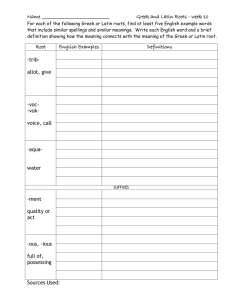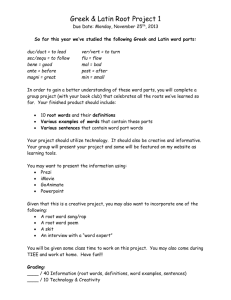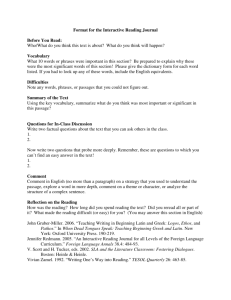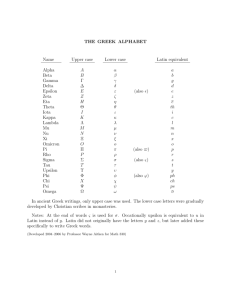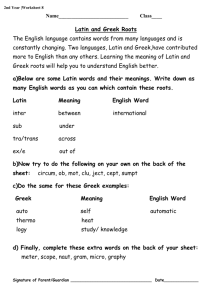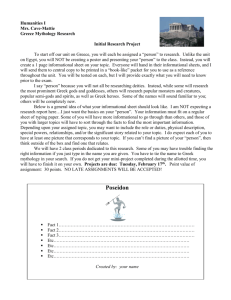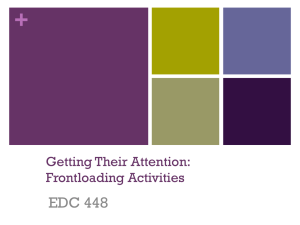Background Knowledge - Defined
advertisement
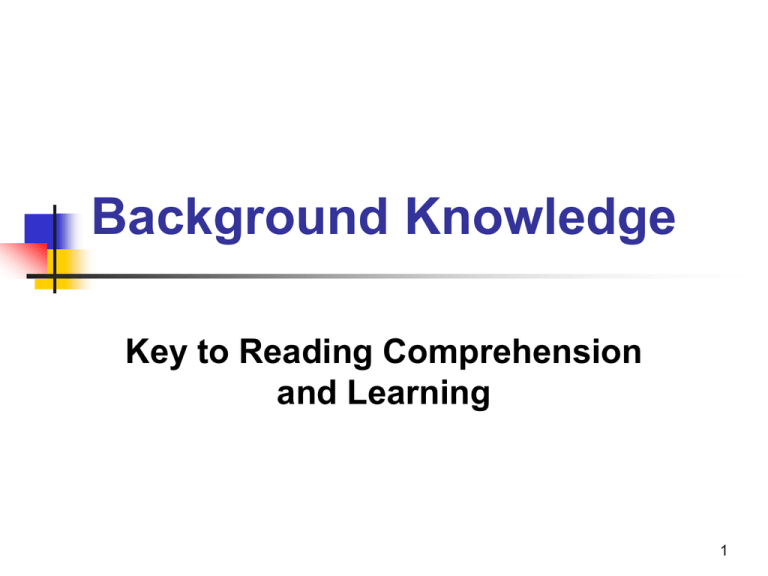
Background Knowledge Key to Reading Comprehension and Learning 1 Anita L. Archer, PhD Educational Consultant and Author archerteach@aol.com 2 Background Knowledge - What? ….what one already knows about a subject. Stevens, 1980 …all knowledge learners have when entering a learning environment that is potentially relevant for acquiring new knowledge. Biemans & Simons, 1996 3 One-minute Quick List 4 Background Knowledge - What? Personal Background Knowledge Academic Background Knowledge Declarative Knowledge Facts Word meanings Academic concepts Schema Relevant personal experiences Political, social, historical contexts Procedural Knowledge Procedures Strategies 5 Background Knowledge - What? Schema Defined Reader’s schema is organized knowledge of the world, which provides information for comprehending, remembering ideas, and learning. Anderson, 1994 Teachers encourage schema building by helping students build background knowledge, access the background knowledge, and use it to bridge new learning. Rea & Mercuri, 2006 6 Background Knowledge - What? Background knowledge is related to the subject. When adults were tested on knowledge of 20 academic subjects, their knowledge varied from subject to subject. Rolfhus & Ackerman, 1999 Thus, background knowledge must be built subject by subject. 7 Why important? Background Knowledge & Comprehension Background knowledge of text has a major impact on whether or not a reader can comprehend text. Anderson & Pearson, 1984; Bransford, Stein, & Shelton, 1984; Wilson & Anderson, 1986 Across grades and reading ability, prior knowledge of subject area and key vocabulary results in higher scores on reading comprehension measures. Langer, 1984; Long, Winograd, & Bridget, 1989; Stevens, 1980 8 Why important? Background Knowledge & Comprehension Read this paragraph and explain it to your partner. From a neuroanatomy text (found in Background Knowledge by Fisher and Frey) Improved vascular definition in radiographs of the arterial phase or of the venous phase can be procured by a process of subtraction whereby positive and negative images of the overlying skull are imposed on one another. 9 Why important? Background Knowledge & Comprehension Read this paragraph and explain it to your partner. ( Background Knowledge by Fisher and Frey) How much a reader already knows about the subject is probably the best predictor of reading comprehension. When readers engage with a text for which they have limited background knowledge, the text is much more difficult to understand than one for which they have ample background knowledge. …research indicates that children continue to spin their wheels when they don’t have the background knowledge required to understand much of what they are reading. p2 10 Why important? Background Knowledge & Processing Fill in partial notes. n n 1. 2. 3. 4. 5. Provides ________________ for understanding text. Helps reader decide where to _______________. Allows the reader to make ___________________. Provides a guide to _________ ______________. Helps produce hypotheses about ______________ that is missing. Anderson, Anderson, & Pichert, 1978 Allows the reader to ____________ more. Enhances _____________ of processing. 11 Why important? Background Knowledge & Processing 1. 2. 3. 4. 5. 6. 7. Provides scaffolding for understanding text. Helps reader decide where to attend. Allows the reader to make inferences. Provides a guide to search memory. Helps produce hypotheses about information that is missing. Anderson, Anderson, & Pichert, 1978 Allows the reader to remember more. Enhances speed of processing. 12 Why important? Background Knowledge & Processing Allows the reader to make inferences. Determine the meaning of each sentence. 1. Harry Thompson was the Benedict Arnold of the oil industry. 2. This action may be no more dangerous than the seeking of African uranium. 3. They headed towards the gate under Sousa’s spell. 13 Why important? Background Knowledge & Learning “Students who lack sufficient background knowledge or are unable to activate it may struggle to access, participate, and progress through the general curriculum.” Strangman, Hall, & Meyer, 2004 14 Why important? Background Knowledge & Learning Average correlation between person’s background knowledge of a given topic and extent to which a person learns new information is .66. Marzano, 2004 Prior knowledge has a large influence on student performance, explaining 30 to 60% of variance in performance. Docy, Segers, & Buehl, 1999 15 Why important? Background Knowledge & Writing Background knowledge is important in expository writing. Students who know little about an assigned topic have difficulty writing about it. Davis & Winek, 1989 16 Why Important? Background Knowledge & Income Significant relationship between knowledge of academic information and type of occupation and overall income. Stricht, Hofstetter, & Hofstetter, 1997 17 Background Knowledge and Memory Sensory Memory Attends to sensory information Very selective Filters out much sensory information Extremely short term 18 Background Knowledge and Memory Working Memory Also referred to as short-term memory Allows us to temporarily store and manipulate information Can process 7 bits of information at a time (Miller, 1956) Cowan (1998) suggested 4 bits of information more accurate Quality & type of processing in working memory dictates whether information makes it to permanent memory Repeated practice with details added and associations made 19 Background Knowledge and Memory Permanent Memory Also referred to as long-term memory Stores background knowledge Activated by related item in working memory Sometimes activated without our awareness 20 Background Knowledge - How? Instruction on background knowledge can significantly improve students’ comprehension of relevant reading materials. Dole, Valencia, Greer, & Wardrop, 1991; Graves, Cooke, & Laberge, 1983; McKeown, Berk, Sinatra, Loxterman, 1992; Stevens, 1982 21 Background Knowledge - How? Ways of addressing background knowledge 1. 2. 3. On-going Instruction Frontloading Passage Reading and Unit General Background knowledge Activities 22 On-going Instruction Today’s Knowledge = Tomorrow’s Background Knowledge Must be stored in permanent memory (long term memory) to serve as background knowledge. 23 On-going Instruction Today’s Knowledge = Tomorrow’s Background Knowledge Provide explicit instruction. Teach to mastery. Support memory. Intend Organize Rehearse (Minniger, 1984; Yates, 1966) 24 On-going Instruction Today’s Knowledge = Tomorrow’s Background Knowledge Intend Teacher - This information/strategy/skill is important because….. - We need to remember …… - The most important idea is…. - Let’s review…… Students - I will take notes / highlight /web / complete graphic organizer / summarize/ …. - I will study …. 25 On-going Instruction Today’s Knowledge = Tomorrow’s Background Knowledge Organize Big ideas (Example) Problem (economic or people’s rights) Solution Effect (problem ends, problem continues, causes a new problem) Carnine, Crawford, Harness, Hollenbeck and Miller, 1998 Graphic organizers (See Examples 1 - 7) Schema 26 On-going Instruction Today’s Knowledge = Tomorrow’s Background Knowledge Rehearse -Repeated practice needed -The more times students process information the more likely they are to remember it. (Marzano, 2004) -Students require 4 exposures to information to adequately integrate into background knowledge (within a 2 day period) Nuthall, 1999 27 On-going Instruction Today’s Knowledge = Tomorrow’s Background Knowledge Rehearse Provide judicious practice (Burke, Hagan, & Grossen, 1998) Provide sufficient practice opportunities Initial instruction Distributed practice Cumulative review 28 On-going Instruction Today’s Knowledge = Tomorrow’s Background Knowledge Rehearse Develop a PLAN for practice Science Teacher’s Plan Rehearse information during lessons Entry tasks - Two Questions on current topic Two Review Questions Exit tasks - Big Ideas from Today’s Lesson Friday Review - Teach Previous Graphic Organizer to Partner Play Quizlet Vocabulary Review Game 29 Background Knowledge BIG IDEA Even a thin slice of background knowledge is useful. 30 Frontloading Passage Reading Passage Specific Background Knowledge Instruction Frontloading Teach or Activate 31 Frontloading Passage Reading - Teach Goals of frontloading To increase _________________of unit, chapter, or passage. To increase ease of ______________ __________. To increase learning of new information by connecting to _________ __________information. To reduce cognitive _________________. 32 Frontloading Passage Reading - Teach Goals of frontloading To increase comprehension of unit, chapter, or passage. To increase ease of processing information. To increase learning of new information by connecting to previously learned information. To reduce cognitive “overload.” 33 Frontloading Passage Reading - Teach Preparation 1. What is critical? 2. What information would ease acquisition of new knowledge? 3. What information would reduce cognitive overload? 34 Frontloading Narrative Passage Reading - Teach If little or no knowledge of book’s subject, comprehension and enjoyment are impaired. (Anderson & Hite, 2010) 35 Frontloading Narrative Passage Reading - Teach Three approaches 1. 2. 3. Teacher-lead preview based on story grammar elements Student preview strategy to build a schema for enjoying new novel Explicit Instruction on: Setting Historical context 36 Frontloading Narrative Passage Reading - Teach Teacher-lead preview focusing on story grammar elements (based on Graves et. al, 1983) Examine Plot Synopsis (back cover/front flap) title settings (Provide historical background.) characters (Provide descriptive list of characters.) conflict plot events theme (See Example 8) 37 Frontloading Narrative Passage Reading - Teach Student preview strategy to build a schema for enjoying new novel (adapted from Anderson & Hite, 2010) Student Sleuth extracts information from: Back Cover or Book Jacket Flap Synopsis of story Setting - When and Where Main character - Name, age, characteristics Conflict Reviews Theme Conflict Genre (Continued on next slide.) 38 Frontloading Narrative Passage Reading - Teach Cover Title - Meaning? Illustration Character’s actions Clues about setting Publication date Author’s foreword Why was the book written Information on the historical setting (See Example 9) 39 Frontloading Narrative Passage Reading - Teach Explicit Instruction concerning: Setting of story Historical context Anchor in Power-Point Informational article Visuals Video 40 Frontloading Narrative Passage Reading - Teach - Anchor in Power-Point Example 10. Number the Stars - Historical Context Reflect on the lesson that you just participated in. Record good practices. 41 Frontloading Narrative Passage Reading - Teach - Anchor in Informational Article Video #1 - Historical context of biography about Harriet Tubman. Record good instructional practices. 42 Frontloading Narrative Passage Reading - Teach - Anchor in Visuals Reflect on the photographs. What might you conclude about the Night of the Broken Glass? 43 Frontloading Informational Text Teach Directly teach necessary background knowledge Anchor in: power-point read aloud informative text or article visuals (pictures, illustrations) graphic organizer video Preview the chapter 44 Frontloading Informational Text Teach Instructional Routine for Background Segment of Lesson Opening Goal - What (Intend) Purpose - Why (Intend) Body Teach information and Vocabulary Require active participation (Rehearse) Stress Big Ideas (Organize) Organize ideas (graphic organizer, think sheet, notes, partial notes, or vocabulary log (Organize) Closing Review (Rehearse) Preview 45 Frontloading Informational Text Teach - Video #2 (The Great Depression) As you watch this video, record any good practices and any missed opportunities. 46 Frontloading Informational Text Teach - Anchor in Visuals Have students interpret topic - related pictures. Croll, et. al, 1986 Using visuals especially helpful to English Language learners. Hudson, 1982; Fitzgerald & Graves, 2004/2005 47 Frontloading Informational Text Teach - Anchor in Graphic Organizer Provide students with an outline or graphic organizer overview of facts and concepts that show relationship among the concepts and ideas in the chapter. Darch & Gersten, 1986; Griffin, Simmons, & Kame’enui, 1991) (See Example 11. Use of Visuals and Graphic Organizer for Kingdoms.) 48 Frontloading Informational Text Teach - Anchor in Video Select well-crafted video. Appropriate length Major points stressed Matches necessary background knowledge Opportunity to focus on visual literacy skills. (Cena & Mitchell, 1998) 49 Frontloading Informational Text - Teach - Anchor with Video Instructional procedure. 1. Focus: Establish a focus for watching the video. 2. Response: Ask students to take notes, complete partial notes, or complete a think sheet or other graphic organizer.Tell students that they will be sharing with their partners. 3. Share: Have students share their observations with their partners or team. 4. Discuss: Lead students in a discussion of the main ideas from video. 5. Review/Rehearse: Ask students questions on the critical content. 50 Frontloading Informational Text Preview As the student previews, he/she discovers: the topics to be covered, the information that will be emphasized, how the material is organized. In addition, background knowledge is activated. 51 Frontloading Informational Text Preview Guide students in previewing the chapter and formulating a topical outline using the text structure: title, introduction, headings, subheadings, questions. (See Example 12) Has students preview the selection independently, with his/her partner, or team members. 52 Frontloading Informational Text Preview Warm-Up Before you read a chapter or a section of a chapter in your science, social studies, or health book, Warm-up. Get an idea of the chapter’s content by previewing these parts. BEGINNING Title Introduction MIDDLE Headings Subheadings END Summary Questions Curriculum Associates, Skills for School Success 53 Vocabulary Instruction Background knowledge is evidenced in vocabulary. 54 Background Knowledge - Vocabulary Vocabulary and background knowledge have the potential to be two of the more powerful means of improving learning and comprehension of adolescent readers Cromley & Azevedo, 2007 55 Vocabulary Instruction Why Important? Science “The specialized vocabulary knowledge in science represents the concept-laden hooks on which learning is hung and enables students to build prior knowledge through the expansion of these conceptual hooks.” Rupley & Slough, 2010 56 Vocabulary Instruction Why Important? Vocabularies used in science often denote meanings unlike the general everyday general language use. Rupley & Slough 2010 Parent - mother or father Chemistry - parent molecules starting component in chemical reaction Biology - parent - any organization that produces or generates another Physics - first nuclide in a radioactive series 57 Vocabulary Instruction “direct vocabulary instruction has an impressive track record of improving students’ background knowledge and comprehension of academic content.” Marzano, 2001, p. 69 .97 effect size for direct teaching of vocabulary related to content (Stahl & Fairbanks, 1986) 58 Vocabulary Instruction Attributes of Good Vocabulary Instruction 1. 2. 3. 4. 5. 6. 7. 8. Select of words that enhance academic success. Content Vocabulary -___________________ knowledge Academic Vocabulary - _________________ across domains Group words ___________________. Provide __________________ explanations. Teach _______________ of words. Provide ________________exposures to terms and meanings. Expand instruction to “word _____________________”. Have students maintain a ______________ of vocabulary terms. Provide judicious _____________________. 59 Vocabulary Instruction Attributes of Good Vocabulary Instruction 1. 2. 3. 4. 5. 6. 7. 8. Select of words that enhance academic success. Content Vocabulary - Background knowledge Academic Vocabulary - Generalize across domains Group words semantically. Provide student-friendly explanations. Teach parts of words. Provide multiple exposures to terms and meanings. Expand instruction to “word relatives”. Have students maintain a log of vocabulary terms. Provide judicious review. 60 Vocabulary Instruction Selection of Words In content area classes, add “Academic Vocabulary” to content area words. Example: Holt World History: The Human Journey, Chapter 13, Section 2 Suggested words - feudalism, fief, vassal, primogeniture, manorialism, serfs, chivalry Added “Academic Vocabulary” - inherit, inheritance; analyze, analysis 61 Vocabulary Instruction Selection of Words In content area classes, add “Academic Vocabulary” to content area words. Example: Prentice Hall, Science Explorer: Earth’s Changing Surface Chapter 3, Section 2 Suggested words - runoff, rills, gully, stream, river, drainage basin, divide, flood plain, tributary,meander, oxbow lake, alluvial fan, delta, ground water, stalactite, stalagmite Added “Academic Vocabulary” - feature, deposit 62 Vocabulary Instructional Routine Step 1. Introduce the word. a) b) Write the word on the board or display on the screen. Read the word and have the students repeat the word. If the word is difficult to pronounce or unfamiliar have the students repeat the word a number of times. This is particularly important for science terms. (Pronunciation help: www.howjsay.com) Introduce the word with me. This word is element. What word? element Element is a noun. 63 Vocabulary Instructional Routine Step 2. Introduce meaning of word. Option A. Critical Attributes Present the meaning of the vocabulary term by breaking the definition into the critical attributes (parts). OR Have students locate the definition in the glossary or text and break the definition into the critical attributes. Glossary Entry: An element is a pure chemical substance consisting of one type of atom. An element can not be broken down by chemical means. Critical Attributes: Element - pure chemical substance - one type of atom - can not be broken down by chemical means 64 Vocabulary Instructional Routine Step 2. Introduce meaning of word. Option B. Present a student-friendly explanation. a) Tell students the explanation. OR b) Have them read the explanation with you. Present the definition with me. When something is required and you must do it, it is compulsory. So, if it is required and you must do it, it is _______________. compulsory 65 Vocabulary Instructional Routine Step 2. Introduce meaning of word. Option C. Introduce the word using the meaningful parts of the word. autobiography auto - self bio - life graph -words/letters photosynthesis photo - light subterranean terra - land epidemic demo - people 66 Common Latin and Greek Roots aqua water Greek aquarium, aqueduct, aquaculture, aquamarine, aquaplane, aquatic aud hearing Latin audio, audition, audiovisual, auditorium, audiotape, inaudible auto self Greek autograph, autobiography, automobile, autocrat, autonomy astro star Greek astronomy, astrophysics, astrology, astronaut, astronomer, asterisk biblio book Greek Bible, bibliography, bibliophobia, bibliophile, biblioklept bio life Greek biography, biology,autobiography, bionic, biotic, antibiotic, biome, bioshere, biometrics chrono time Greek synchronize, chronology, chronic, chronicle, anachronism corp body Latin corpse, corporation, corps,incorporate, corporeal, corpulence demo the people Greek democracy, demography,epidemic, demotic, endemic, pandemic dic, dict speak, tell Latin dictate, dictation, diction, dictator, verdict, predict, contradict, benediction, jurisdiction, predict, indict, edict dorm sleep Latin dormant, dormitory, dormer, dormouse, dormition, dormitive geo earth Greek geology, geologist, geometry, geography, geographer, geopolitical, geothermal, geocentric 67 Common Latin and Greek Roots graph to write, to draw Greek autograph, biography, photograph, telegraph, lithograph hydro water Greek hydroplane, dehydrate, hydroelectric, hydrogen, hydrophone ject throw Latin reject, deject, project, inject, injection, projection logos, logy study Greek geology, astrology, biology, numerology, zoology, technology, psychology, anthropology, mythology luna moon Latin lunar, lunacy, lunatic, interlunar meter measure Greek meter, thermometer, diameter, geometry, optometry, barometer, centimeter, symmetry, voltammeter mega great, large, big Greek megaphone,megalith, megalomania, megatons, megalopolis min small, little Latin minimal, minimize, minimum, mini, miniature, minuscule, minute, minority mit, mis send Latin mission, transmit, transmission, remit, missile,submission, permit, emit, emissary path feeling, suffering Greek pathetic, pathology, apathy, antipathy, sympathy, telepathy, empathy, sociopath ped foot Latin philia love, friendship Greek pedestrian, pedal, peddle, peddler, pedicure, pedometer 68 philosopher, Philadelphia, philanthropist, philharmonic, Philip Common Latin and Greek Roots phono sound Greek phonograph, microphone, symphony, telephone, phonogram, megaphone, phony, euphony, xylophone, phony, photo light Greek photograph, photosynthesis, telephoto, photometer, photophilia port carry Latin port, transport, transportation, portable, portage, report spect see Latin respect, inspection, inspector, spectator, spectacles,prospect scope look at Greek microscope, telescope, periscope, kaleidoscope, episcopal sol sun Latin solar, solar system, solstice, solarium, parasol struct build, form Latin instruct, instruction, construction, reconstruction, destruct, destruction, infrastructure, construe, instrument, instrumental tele distant Greek telephone, television,telegraph, telephoto, telescope, telepathy, telethon, telegenic terra land Latin territory, terrestrial, terrace, terrarium, extraterrestrial, Mediterranean Sea, terra cotta, subterranean 69 Vocabulary Instructional Routine Step 3. Illustrate the word with examples and non-examples. a) b) c) Concrete examples. Visual examples. Verbal examples. 70 Gold - What do we know about gold? 71 What do you know about gold? An element Consists of only one type of atom Cannot be broken down by chemical means 72 Mercury - What do we know about mercury? 73 What do you know about mercury? An element Consists of only one type of atom Cannot be broken down by chemical means 74 Vocabulary Instructional Routine Step 4. Check students’ understanding. Option A. Ask deep processing questions. Option B. Have students discern between examples and non-examples. Option C. Have students generate their own Examples and non-examples. 75 Vocabulary Instructional Routine Video #3. Vocabulary Instruction prior to reading Harriet Tubman. Please note any good practices and missed opportunities. 76 Vocabulary Instruction 1. When feasible introduce the vocabulary term in relationship to other terms using a graphic organizer. 2. Introduce the part of speech. 3. Introduce synonyms (same), antonyms (opposite), homographs (same spelling - different meaning). 4. Tell students when and where the word is often used. 5. When appropriate, introduce the etymology (history and/or origin) of the word. 6. Introduce other words in the same word family (derivatives). 77 Vocabulary Instruction Producing metals Metals Minerals Gems Prospecting Mining Smelting 78 Vocabulary Instruction Have students maintain a vocabulary log. The log can be used for: Scheduled vocabulary reviews with the class. Study with a partner or a team. Self-study of vocabulary. (See Examples 13 and 14) 79 Practice Activities Practice activities should: Be engaging. Provide multiple exposures to the words. (Stahl, 1986) Encourage deep processing of the word’s meaning. (Beck, Mc Keown, & Kucan, 2002) When possible, connect the word’s meaning to prior knowledge. Provide practice over time. Example: Quizlet 80 Background Knowledge - Activate Activate Background Knowledge Reflection and Recording Anticipation guide Cloze Semantic Mapping These evidenced-based practices can be used to activate background knowledge and assess entering level of knowledge. 81 Background Knowledge - Activate Reflection and Recording Reflection and Recording 1. Have students state, write down, or record what they know about the topic. What do I already know about this topic? Carr & Thompson, 1996; Peeck, van dem Bosh & Keupling, 1982; Smith, Readence & Alvermann, 1983; Spires & Dontey, 1998; Walraven & Reitsma, 1993 2. After reflecting and recording, engage students in a group discussion of the topic. Dole, et. al, 1991; Schmidt & Patel, 1987; King, 1994; Hansen & Pearson, 1983. 82 Background Knowledge - Activate Teacher-directed instruction focused on information necessary for understanding text, more effective than activating student knowledge and discussing it. Dole, Valencia, Greer, & Wardrop, 1991 83 Background Knowledge - Activate Cloze Procedure Cloze Procedure 1. Select a self-contained reading passage. 2. Leave first and last sentence and all punctuation intact. 3. Carefully select the words for omission by using a word count formula, such as every fifth word, or other criteria. Delete words that carry meaning, such as nouns, main verbs adjectives, and adverbs. 4. Have students read the entire passage before they fill in blanks. 5. Encourage the students to fill each blank. 6. Give students an appropriate amount of time to complete the task. 7. Prompt students to reread the completed passage. Kroeger, Burton, and Preston, 2009; Taylor, 1953 84 Background Knowledge - Activate Cloze Procedure Students’ background knowledge is highly related to reading comprehension and overall learning. Given that students often have little ___________of the topic, the teacher can ____________the passage reading either by teaching _______________ background knowledge or by activating background _________________________. When introducing background knowledge directly, the ______________can be anchored to a power-point presentation, _________informational article, visuals, a video, or ______________organizer. The teacher can promote retention of ______________information by using three practices: intend, ___________, and rehearse. Similarly, the teacher can provide ______________instruction on vocabulary terms. Studies have consistently validated the benefits of explicit instruction on critical background knowledge and vocabulary. 85 Background Knowledge - Activate Cloze Procedure Students’ background knowledge is highly related to reading comprehension and overall learning. Given that students often have little knowledge of the topic, the teacher can frontload the passage reading either by teaching critical background knowledge or by activating background knowledge. When introducing background knowledge directly, the instruction can be anchored to a power-point presentation, an informational article, visuals, a video, or a graphic organizer. The teacher can promote retention of the information by using three practices: intend, organize, and rehearse. Similarly, the teacher can provide explicit instruction on vocabulary terms. Studies have consistently validated the benefits of explicit instruction on critical background knowledge and vocabulary. 86 Background Knowledge - Activate Anticipation Guide Anticipation Guide 1. The teacher reads the chapter and determines the most important ideas that students should gain. 2. These ideas are stated either as true or false statements. 3. Before reading the chapter, the students read each statement and indicate if they believe the statement is true or false based on their current background knowledge. 4. After reading the chapter and participating in other learning activities, the students read each statement and indicate if they believe the statement to be true or false based on their expanded knowledge. 5. (Optional) Students rewrite false statements, creating true statements. In the end, the students will have a summary of key ideas. 87 Background Knowledge - Activate Semantic Mapping 1. 2. 3. 4. Have students generate a list of words that they associate with the concept. Next, have students generate categories for the words. Then, students record words from their list with a matching category. Semantic mapping can be done individually, in pairs, or in cooperative teams. (See Example 16) 88 General Background Knowledge Activities Real Experiences Virtual Experiences Wide Reading School-wide Vocabulary Program 89 General Background Knowledge Activities Real Experiences Field trips Museums Art Galleries Court Houses Cemeteries 90 General Background Knowledge Activities Virtual Experiences Virtual field trips Virtual dissection labs 91 General Background Knowledge Activities Wide Reading Large differences in amount of independent reading by students at different reading levels. Students at the 90th percentile encounter 200 times more words than students at the 10th percentile. Anderson, Wilson, & Fielding, 1986 92 Variation in Amount of Reading Percentile Rank Minutes per day reading in books Minutes per day reading in text Words per year in books Words per year in text 98 65.0 67.3 4,358,000 4,733,000 90 21.2 33.4 1,823,000 2,357,000 80 14.2 24.6 1,146,000 1,597,000 70 9.6 16.9 622,000 1,168,000 60 6.5 13.1 432,000 722,000 50 4.6 9.21 282,000 601,000 40 3.2 6.2 200,000 421,000 30 1.8 4.3 106,000 251,000 20 0.7 2.4 21,000 134,000 10 0.1 1.0 8,000 51,000 2 0 0 0 8,000 93 Increasing Amount of Independent Reading Maximize access to books. Extended library hours Classroom libraries Book sales, book exchanges Establish time for independent reading. Silent Sustained Reading Partner Reading BUT don’t substitute silent reading for reading instruction. Expect reading outside of class. 94 Increasing Amount of Independent Reading Encourage selection of books at the independent reading level. Teach the “five-finger test”. Encourage students to read “familiar” books. Same author Same character Same genre Books in a series 95 Increasing Amount of Independent Reading Enhance personal motivation. Establish a school climate that encourages reading. Have book-rich environments. Provide book recommendations. Bulletin boards posted with recommendations Book tables Book clubs 96 General Background Knowledge Activities -Television??? Television viewing seemed to add nothing to development of background knowledge. Stanovich & Cunningham, 1993 Type of television moderates background knowledge. Hall, Chiarello, Edmonson, 1996 Entertainment - Does not increase background knowledge. Educational - Increases background knowledge. 97 General Background Knowledge Activities School-wide Reading Program Word Generation Program 98 One-minute Quick List 99 Thank You How well we teach = How well they learn Teaching for Remembering Intend Organize Rehearse 100
